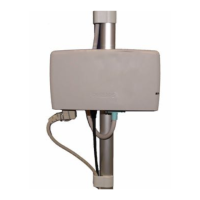14 Monitoring Carbon Dioxide Measuring CO
2
using the CO
2
Option or M3014A
172
Depending on the Max Hold setting configured for your monitor, the etCO
2
numeric shows either
the highest CO
2
value measured within the configured time period (Max Hold set to 10 sec or
20 sec) or the etCO
2
numeric shows breath-to-breath value (Max Hold set to Off).
WARNING Correlation: The etCO
2
readings do not always correlate closely with paCO
2
, especially in neonatal
patients and patients with pulmonary disease, pulmonary embolism or inappropriate ventilation.
Pharmaceuticals in aerosols: Do not measure CO
2
in the presence of pharmaceuticals in aerosols.
Explosion Hazard: Do not use in the presence of flammable anesthetics or gases, such as a flammable
anesthetic mixture with air, oxygen or nitrous oxide. Use of the devices in such an environment may
present an explosion hazard.
Failure of operation: if the measurement or a sensor fails to respond as described, do not use it until
the situation has been corrected by qualified personnel.
Low etCO
2
values: Leakages in the breathing system or sampling system may cause the displayed
etCO
2
values to be significantly too low. Always connect all components securely and check for leaks
according to standard clinical procedures. Displacement of the nasal or combined nasal oral cannulas
can cause lower than actual etCO
2
readings. Even with combined nasal oral cannulas, the etCO
2
readings may be slightly lower than actual in patients breathing through the mouth only.
Measuring CO
2
using the CO
2
Option or M3014A
The monitor (with the CO
2
option) or the M3014A Capnography Extension measures partial pressure
of carbon dioxide in a patient’s expired gas using the mainstream method or the sidestream method.
The mainstream CO
2
measurement can be used, with appropriate accessories, with intubated adult,
pediatric and neonatal patients. The sidestream CO
2
measurement can be used, with appropriate
accessories, with intubated and nonintubated adult, pediatric, infant and neonatal patients. With
intubated patients, a sample of the respiratory gas is drawn from the patient’s breathing circuit through
an airway adapter and a gas sampling tube. With non-intubated patients, the gas sample is drawn
through a nasal or oral-nasal cannula.
WARNING Altitude Setting: The monitor is not equipped with automatic barometric pressure compensation.
Before the CO
2
measurement is used for the first time, the altitude must be set to the correct value. An
incorrect altitude setting will result in incorrect CO
2
readings. The CO
2
readings will typically deviate
5% for every 1000m difference.
Preparing to Measure Mainstream CO
2
You must perform a zero as described in this procedure each time you use a new airway adapter.
1 Attach the sensor connector to the CO
2
connector on the monitor (when the optional CO
2
measurement is integrated) or on the extension.
2 Wait 2 minutes, allowing the sensor to reach its operating temperature and a stable thermal
condition.

